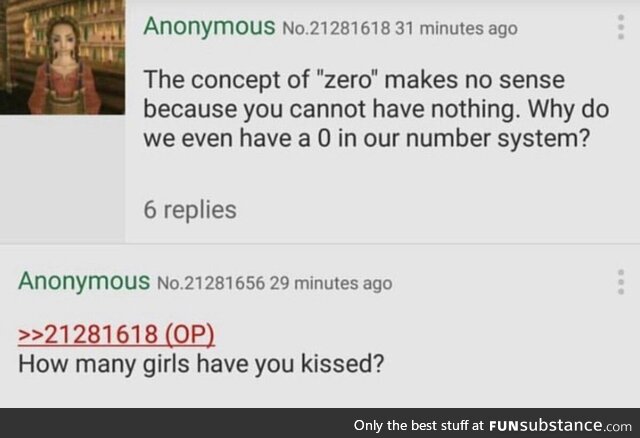Featured Posts

I wish I had a fort

The powerof positive thinking

NASA

Pray for Australia

Take care of each other

She has emerged

My soul feels so much better

I just ordered one. #Just2019HispanicThings

He really wanted his photo at the Halloween party, but was super scared of the spiders

The Only Thing More Contagious Than COVID19 Might Be This Fox's Smile
About
FAQ
Contact
Rules
Terms
Privacy
Feedback
Keyboard Shortcuts:
Previous Post · Next Post · + CTRL Skip Post
Previous Post · Next Post · + CTRL Skip Post
© 2025 FunSubstance · funny and entertaining pictures, memes, gifs & videos.



In other words, you do not have nothing and Jim has 5 apples, you have less than the minimum countable number of apples and Jim has 5 apples. It’s abstract. Saying “I do not have any cake” is the same as saying you have 0 cake in concept. Linguistically we use different phrasing when discussing the non quantifiable but math is a different language. Importantly- math has ways to differentiate that which is unquantifiable because it is not observable- 0 apples, I do not observe you having any apples. Non quantifiable because it is two small to express but is present or observable, non quantifiable because it is too large or it’s magnitude is not observable but is present etc.
critically thought, “0” must apply to something. It can’t exist on its own. An example is zero apples- zero applies to apples, if you had nothing you’d be naked and skinless and boneless and nonexistent-
“When you turn on a calculator it says zero- so zero is existing alone- check mate!”
Not so fast dear friend. That is zero the place holder and it never exists alone. Blank would imply nothing. A zero is there to represent that you have zero of a specific thing. In this case you have zero ones in your ones column. Place a decimal and you have 0 ones or 0 tenths and so on. We don’t always show zero and that blank doesn’t exactly represent nothing. Technically we could write “100” as “00100.0000000” or “0000000000000000000000000000000000000000000000000000000100.0000000000000000000000000” or we could put a billion or a googolplex or “infinite” zeros and never finish writing a single number.
There are exceptions to this but zero as a place holder exists as a convenience to fill relevant data fields primarily for formatting and parsing.
“Balance the equation.” This isn’t some silt rule, it’s a matter of perception and reality.
If you and I want to compare test grades, if I say I received an A, I need to know what you got to compare. If you didn’t complete the test the comparison would be an A to a did not complete. Numerically a 97 to a 0 on a points scale. This is different than if we do not know what you got- we could say 97 to X in this case or express it in writing as “97 to ?”